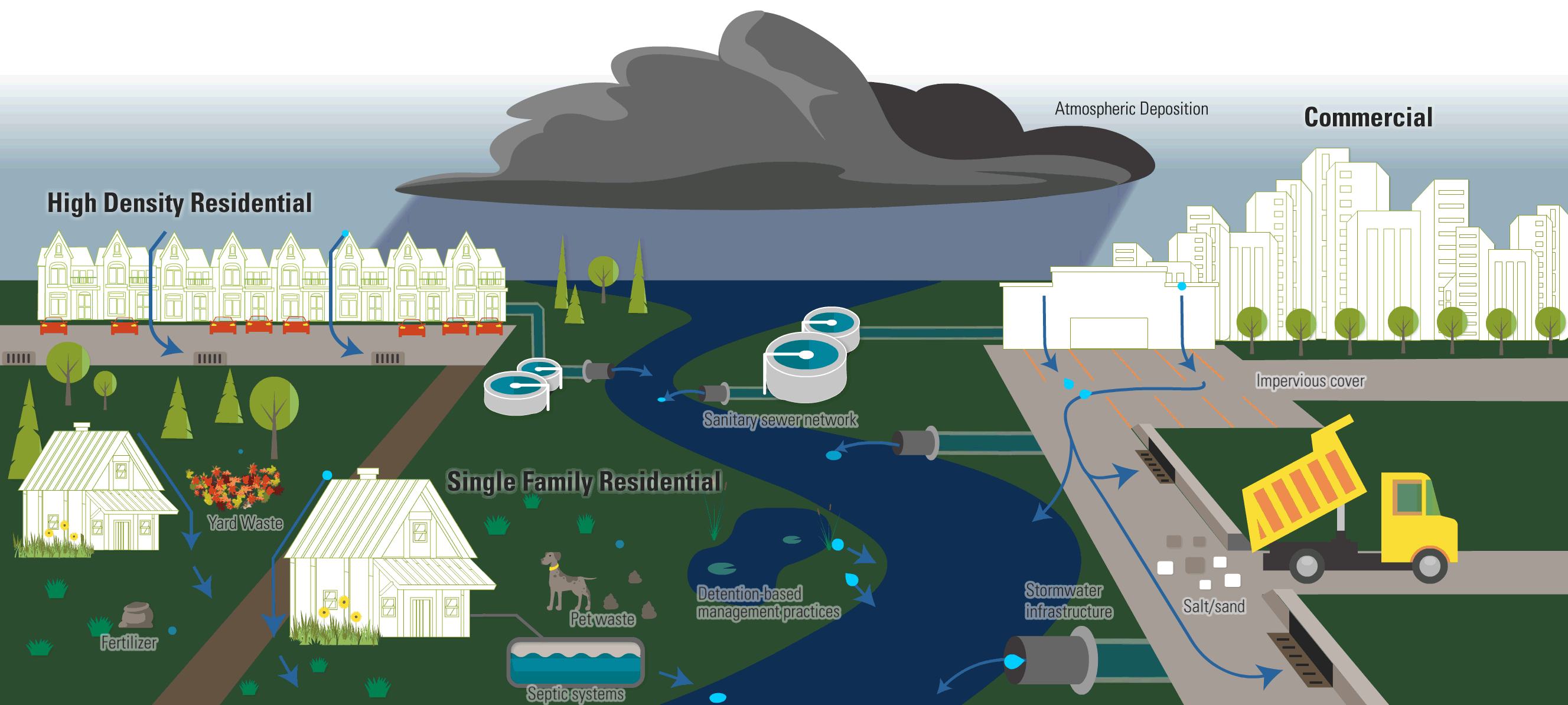Source Water Protection and Water Conservation
Wherever you are, you are in a watershed.
A watershed is all the land that drains to the same river or lake. Water travels from the highest points at the watershed edge to the lowest point at the bottom of the watershed.
Source water protection is a community effort
Source water is the water that feeds our public drinking water supply. It includes groundwater, springs, streams, creeks, rivers, lakes, and reservoirs. Source water protection efforts prevent contaminants from entering the waterways that serve as our drinking water sources.
Why should we protect our source water?
- To protect our drinking water supplies
- To ensure a healthy habitat for ourselves and the countless species we share it with
- To prevent the need for costly, complex treatments that remove pollutants
What threatens our source water?

Eroded Soil & Sediment
When soil and sediment washes into source water, it can transport considerable amounts of some nutrients like organic nitrogen, phosphorus, and some pesticides to rivers and streams.
Point-source Contamination
This type of contamination can be traced to specific points of discharge, for example, wastewater treatment plants, factories, or combined sewers.
Air Pollution
Believe it or not, air pollution can contaminate water! Particles in the air can mix with water and oxygen. They get distributed into water when it rains.
Common Pollutants
- Gasoline or oil from leaking tanks
- Nitrate and pesticides from agriculture and lawns
- Pathogens from livestock and pet waste
- Salt from winter road maintenance
- Chemicals from industrial facilities
How do contaminants get Into our water?
Stormwater
When it rains, some water travels over the land surface. This is called surface runoff or stormwater.
As stormwater flows, it picks up any contaminants lying on the surface. Those small streams join to form larger streams and rivers, until the water – and any contaminants it is carrying – reach the final lake or river.
Groundwater
Some precipitation trickles down through soil and reaches groundwater. The groundwater may pick up nitrates and chemicals. Groundwater is part of a watershed, and that water ultimately flows into one of our streams, rivers or lakes.
Cleanup
Once a water source becomes contaminated, the cleanup often takes many years and can be very expensive. Protecting our drinking water is a community effort.
Help Protect Source Water
- Minimize pesticide and herbicide use on your lawn and garden.
- Bring household hazardous waste (HHW) to county HHW programs. HHW materials include items like motor oil, pool chemicals, and driveway sealant. Find your local drop-off or event here.
- Don’t pour automotive fluids on the ground or in a storm drain. Dispose of motor oil at garages that recycle it, and take other automotive fluids to your local household hazardous waste program.
- Schedule regular septic pump outs every two to three years.
- Do not flush unwanted or leftover medications down the toilet or sink drain. Many local police departments have medication take back boxes. You can find the nearest medication take back program here.
- Don’t dump pool water into a storm drain or body of water. Direct it to a sanitary sewer or allow chlorine to diminish and direct it to foliage. Learn how here.
Water Conservation Makes Sense
You can conserve water everywhere you go! At home, work, school, or out in our community, there are opportunities to reduce your water usage. Here are some quick tips to conserve water:
- Carry and refill a reusable water bottle.
- Turn off the tap while you brush your teeth and wash your hands.
- Check your toilet for a leak. A leak could waste 200 gallons of water every day!
- If you water outdoor plants, do it in the morning before the hot midday sun causes water to evaporate.
- Don’t hand wash your dishes. Fill up the dishwasher and run it.
- When you replace fixtures, choose new fixtures with the EPA WaterSense label.
The US EPA’s WaterSense program identifies water-saving products. It also provides resources to help us all save water, so together, we can act to reduce our water use.
WaterSense provides resources that help reduce water usage at home, at work, at school, in our landscaping, and more.